When it comes to email marketing and communication platforms, two major players stand out: Amazon SES and SendGrid. Choosing between these services is a crucial decision for business owners, with impacts on everything from email deliverability to ease of use.
The right platform can enhance communications and accelerate business growth; the wrong choice can hinder email reliability and customer connections.
In this comprehensive Amazon SES vs SendGrid comparison article, we dive into the key differences between the two email marketing platforms across areas like market popularity, features and functionality, website performance, customer support, pricing, and more. By exploring their respective strengths and weaknesses in-depth, business owners can make an informed decision based on their unique needs and priorities.
1. Understanding the Basics
Founded in 2009, SendGrid is a cloud-based SMTP provider that focuses exclusively on transactional and marketing email delivery. Twilio acquired the company in 2018 for $3 billion. SendGrid powers email communications for leading companies like Airbnb, Spotify, and Uber. With over 80,000 customers globally, it has a strong market position.
Amazon SES launched in 2010 as Amazon’s native email service, tied to its leading AWS cloud platform. It was created specifically for developers building applications on AWS. The service handles deliverability for major companies like Netflix, Slack, and Kayak. As an Amazon product, it benefits from the brand’s expansive cloud infrastructure.
Both providers have active online communities. SendGrid users can join the Email Community Forum on Facebook, while Amazon SES users often discuss issues in the AWS Forum. These groups provide peer advice on optimizing deliverability and leveraging all features.
2. Features and Functionality
Automation
Amazon SES
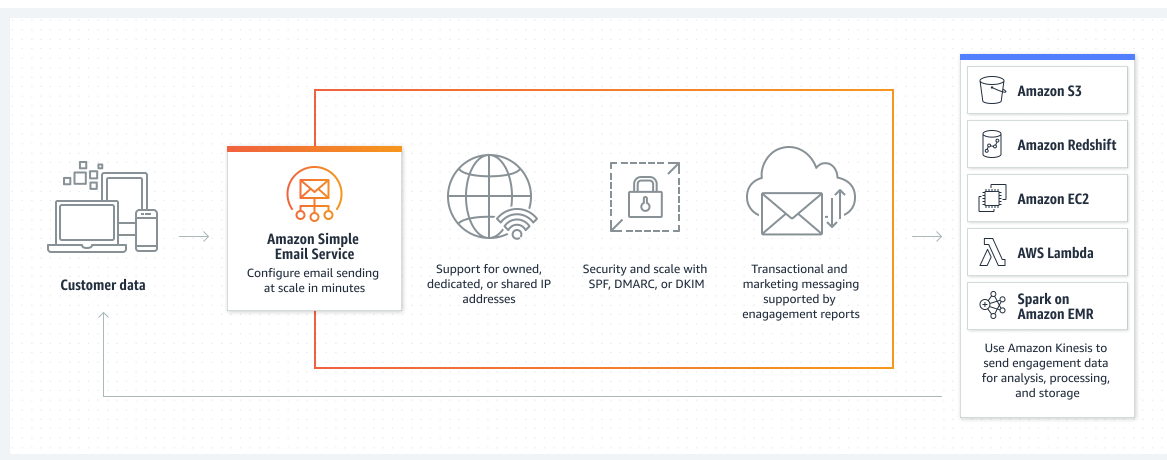
Amazon SES allows users to create email templates that can be reused for campaigns. Templates support drag-and-drop editors for easy editing. Users can also upload HTML files or use code editors for more customization. Dynamic templates enable personalization with replaceable values.
For workflows, Amazon SES focuses more on developer-friendly options. Users can leverage the service’s API and AWS Lambda functions to build custom automations that react to events. However, there is no visual workflow builder for non-coders.
Overall, Amazon SES provides a robust infrastructure for automation but lacks simplicity for non-developers. Marketers may need dev help to set up triggers and sequences.
SendGrid
SendGrid offers strong visual workflow builders like Automation and Email Studio. Automations enable drag-and-drop creation of multi-step workflows based on triggers like email opens, form submissions, etc. Sequences send timed email series to contacts.
For templates, SendGrid has a library of pre-designed templates by industry and campaign type. Users can easily customize templates with an intuitive editor supporting images, dynamic fields, and more. SendGrid also offers unique automation like smart text replacement and contact cleansing.
With its visual workflow builders and template editor, SendGrid makes automation accessible for users of any skill level. Marketers can create complex sequences without coding knowledge.
Winner: SendGrid
With its user-friendly workflow builders and design editors, SendGrid takes the prize for the easiest automation. Marketers can create multi-layered sequences through visual tools versus needing developer resources.
While Amazon SES provides robust infrastructure, SendGrid simplifies the automation process for users of all skill levels. Its versatility makes cross-channel automation achievable for any business.
Email Templates
Amazon SES

Amazon SES allows users to create reusable email templates that support drag-and-drop modules for easy editing. Users can build templates from scratch or leverage pre-designed templates. The editor enables adding, editing, and styling text, images, dynamic content, and more.
Templates can reference stored data sets for dynamic personalization. For example, sending customized purchase receipts using order data variables. Users can also upload pre-designed HTML files or templates from other ESPs.
Overall, Amazon SES provides flexible tools for building customized, branded templates with dynamic content. Developers can tap deeper capabilities too. However, the editor is not as intuitive as other ESPs.
SendGrid
SendGrid offers hundreds of professionally designed email templates for every use case – marketing, transactions, alerts, etc. Users can start campaigns quickly by customizing pre-built templates. Easy-to-use modules make adding images, text, colors, and mail merge tags simple.
For more advanced personalization, SendGrid’s Dynamic Templates allow swapping layouts, content, and styles based on customer data and behaviors. Templates also support versioning and translation for global campaigns.
In all, SendGrid equips any user to create on-brand, effective email templates quickly without design expertise. Pre-built templates accelerate campaign creation while customization provides advanced personalization options.
Winner: SendGrid
While Amazon SES provides solid tools, SendGrid’s vast library of pre-optimized templates makes campaign creation faster for any user. Easy customization and more advanced personalization features like Dynamic Templates also give it the edge for flexibility and convenience. Less experienced email marketers benefit greatly from SendGrid’s intuitive template editor.
Segmentation
Amazon SES
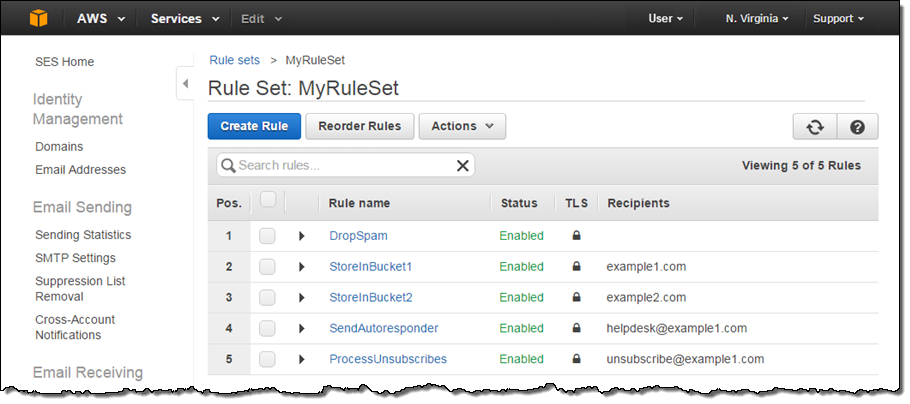
Amazon SES enables segmenting contacts based on various attributes like location, purchase history, behaviors, and more. Users can create dynamic segments with customizable filters for precise targeting.
For example, marketers could segment by contacts who opened a campaign but did not click any links. Or target customers who spent over $500 last year. Granular filtering provides flexibility.
Amazon SES also supports integration with AWS databases for advanced segmentation using custom contact attributes. Users can build highly customized groups. But easy visual segment builders may require developer help.
Overall, Amazon SES has a powerful infrastructure for segmenting contacts but lacks readily accessible tools for less technical users. Marketers may need to code their segments.
SendGrid
SendGrid provides visual segment builders like Contact Lists and Marketing Campaigns for easy audience targeting without coding. Contact Lists allow combining contacts based on attributes like demographics, engagement metrics, purchase data, etc.
Campaigns also auto-segment based on user behaviors like email/link clicks, browsing site pages, etc. Easy tag management with Labels enables grouping contacts manually too.
With its intuitive UI for layered audience filtering, SendGrid empowers all users to identify and build targeted contact segments without technical skills. Granular options yield precise subgroups for hyper-personalization.
Winner: SendGrid
While Amazon SES delivers advanced infrastructure for segmentation, SendGrid’s visual tools give marketers more autonomous control. Any user can easily create filtered contact lists based on behaviors, attributes, metrics, and more for better campaign personalization. For less technical users, SendGrid simplifies the process without limiting customization capability.
Analytics
Amazon SES

Amazon SES provides robust email activity analytics through integration with Amazon CloudWatch. Users get access to metrics like deliveries, bounces, complaints, rejects, latency, open & click rates, unsubscribed, etc. CloudWatch displays graphs and charts for visualization.
Users can filter reports by date ranges, domains, campaigns, and more for deeper analysis. It’s also possible to set performance baselines with targets for metrics like deliverability rate. Alerts notify users of thresholds being met.
While powerful, Amazon SES’s analytics require leveraging other services like CloudWatch. It lacks an intuitive centralized dashboard. The toolset favors developers versus email marketers. Learning to navigate reports has a steeper curve.
SendGrid
SendGrid consolidates email analytics into its easy-to-use Marketing Campaigns dashboard. Users get key metrics like deliveries, opens, clicks, unsubscribes, bounces, spam reports, and more displayed in simple charts. Data can be filtered by date, campaign, custom link tags, and other parameters for segmentation.
The dashboard provides a timeline of email performance and engagement over recent hours, days, or months. Subscription and contact growth charts offer quick follow-up prompts to reengage disengaged subscribers.
Overall, SendGrid makes understanding campaign analytics very straightforward for all users with its visual dashboards rather than relying on code. It offers an all-in-one centralized solution.
Winner: SendGrid
With its simplified dashboards and visualizations consolidated into a single solution, SendGrid provides the most user-friendly analytics. Email marketers can easily track key metrics and quickly segment data without needing developers.
While Amazon SES delivers robust reports, they require synthesizing data across services which poses barriers to rapid use and accessibility compared to SendGrid’s centralized offering.
Unique Features
Amazon SES

A unique advantage Amazon SES provides is tight integration with other AWS services for advanced functionality. For example, SES allows you to replace traditional email mailbox polling with real-time data.
The platform also ties directly into Amazon’s machine learning platform SageMaker for inbox placement optimization. This allows better predicting and enhancing email deliverability through predictive analytics.
Other native integrations like AWS Lambda allow executing custom code to automate processes for sending, analyzing, and actioning emails. The possibilities are robust for developers on the AWS stack.
However, the reliance on separate services also means more complexity in tying solutions together. Additional learning and maintenance across tools is required versus a single unified platform.
SendGrid
Unique SendGrid capabilities include automated contact enrichment with tools like email appending and cleaning. Contact appending fills in missing data like phone numbers based on email addresses. List cleaning detects risky addresses to keep campaigns inbox-focused.
SendGrid also offers free email validation via its Hydro app. This helps maintain list accuracy by verifying deliverability and catching outdated addresses.
Finally, SendGrid provides visibility into email security threats. Link white-labeling hides original links to protect from phishing. Authentication like SPF, DKIM, and DMARC prevents spoofing and verification failures.
Winner: Tie
Both Amazon SES and SendGrid offer exclusive features that set them apart for different needs. For developers building on AWS, Amazon SES provides unparalleled integration with advanced platforms like machine learning and serverless functions. However, this requires more technical knowledge.
SendGrid has an edge for email marketers with its email automation enrichment options and security protections safeguarding deliverability. While slightly less technical, these don’t require additional services either. Ultimately both have strong unique selling points catering to their target customers. Declaring a single overall winner ignores their distinct specialization advantages.
3. Ease of Use
Amazon SES
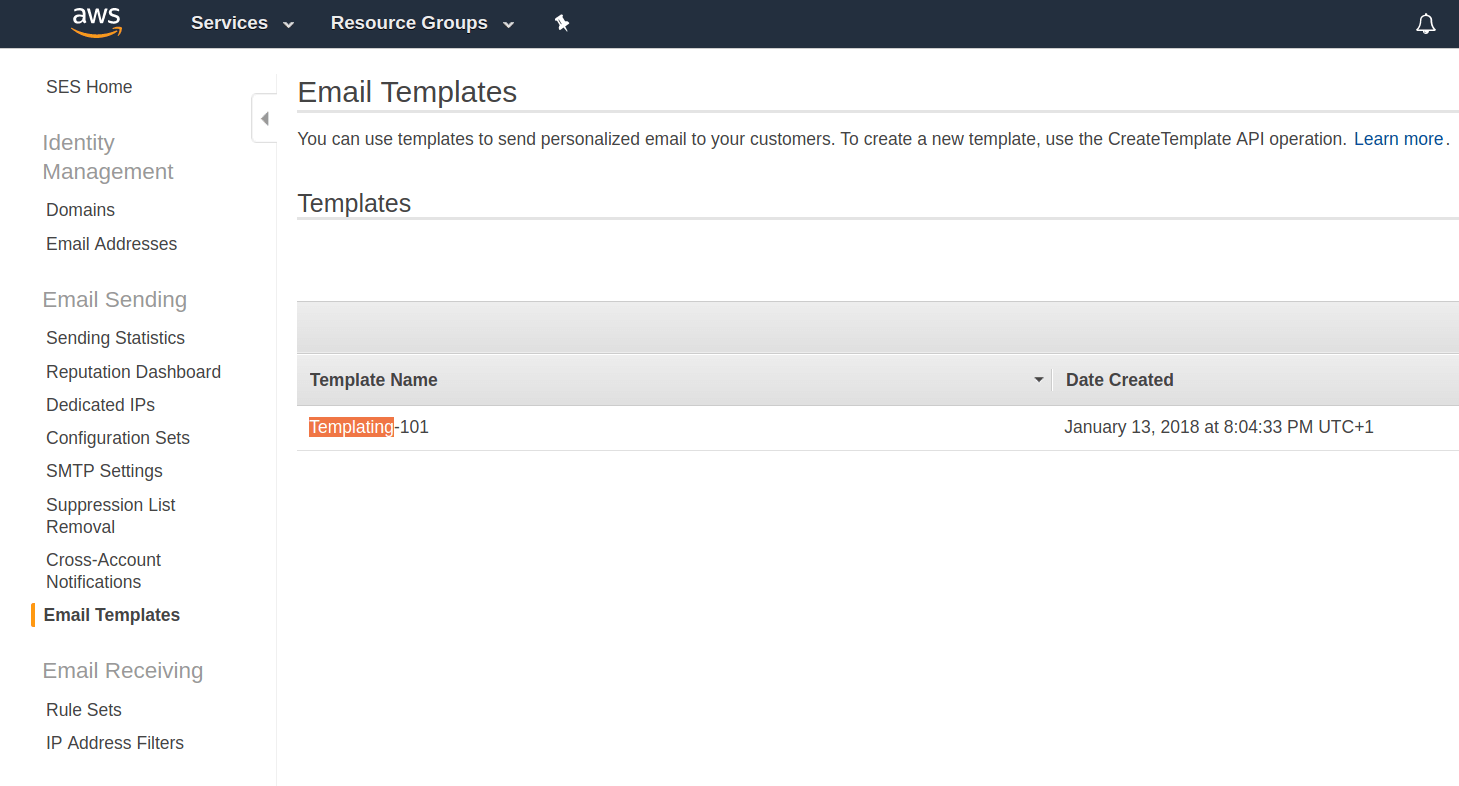
As an infrastructure service built for developers, Amazon SES prioritizes capabilities over simplicity. The UI is dense with technical options versus guided workflows. Many features focus on API implementation, requiring coding skills. This creates obstacles for less technical users like marketers.
The learning curve is steep for mastering Amazon SES email functionality as the platform weaves together various AWS services. Understanding identity management, database integrations, analytics dashboards, etc across tools takes time. Support resources like documentation run deep but are geared toward developers.
Overall, while Amazon SES delivers email reliability and scalability, it does so through a complex user experience favoring technical experts over beginners. Less experienced users will face hurdles leveraging its flexibility.
SendGrid
With email delivery optimization as its sole focus, SendGrid offers a streamlined user experience around intuitive workflows. Clear step-by-step guidance enables users of all skill levels to create and manage email campaigns with no coding necessary.
Simple menu navigation plus drag-and-drop modules across tools like Templates, automation, and Email Testing accelerate campaign creation for beginners. Yet advanced options remain available for experts too. Documentation provides extensive tutorials pitched to various expertise levels as well.
Altogether, SendGrid simplifies leveraging robust email functionality through guided UIs, minimizing the learning curve. Highly complex tasks become accessible to novice senders.
Winner: SendGrid
As a platform built specifically to make email delivery and engagement intuitive, SendGrid beats Amazon SES for usability. Beginners can get campaigns running quickly thanks to simplified menus and pre-built options. Tooltips and docs also ease the learning process across skill levels. While Amazon SES provides tremendous infrastructure, its complexity best serves developers versus general audiences. SendGrid democratizes robust email capabilities through ease of use for all.
4. Email Deliverability
Amazon SES

As an extension of Amazon’s secure cloud infrastructure, Amazon SES provides reliable email delivery and scalability. Its integrated suite of email verification tools like Sender Authentication, Routing, and Tracking optimize for inbox placement across ISPs.
Granular tracking with open-and-click data enables understanding subscriber engagement too. Bounce and complaint handling allows updating contact lists to improve future deliverability through automated or manual list management capabilities.
Overall, Amazon SES gives developers and companies that leverage AWS strong email deliverability and optimization functionality to minimize blacklisting risks.
SendGrid
SendGrid uses a host of proprietary email deliverability features to achieve industry-leading inbox placement. These include comprehensive contact list verification, targeted link white-labeling to avoid phishing triggers, dynamic content personalization to increase open rates and clickthroughs, and more to improve email reputation.
Robust analytics offer insight into subscriber engagement and trends to continually optimize future performance. Automations streamline cleaning bad addresses, updating subscriber topics, and re-engaging inactive contacts to bolster metrics.
In total, unique optimization and automation make SendGrid a leader in email deliverability and drive long-term sender reputation.
Winner: SendGrid
With an intense focus on inbox placement versus general infrastructure, SendGrid edges out Amazon SES for deliverability. Unique proprietary capabilities and automation that bolster email engagement metrics give SendGrid the advantage for senders wanting to avoid the spam folder and maximize reach.
That said, Amazon SES still provides strong core deliverability components for developers on AWS, including simple mail transfer protocol. But for independent apps or non-technical users focused squarely on reputation and inboxing, SendGrid is superior.
5. Customer Support and Community
Amazon SES
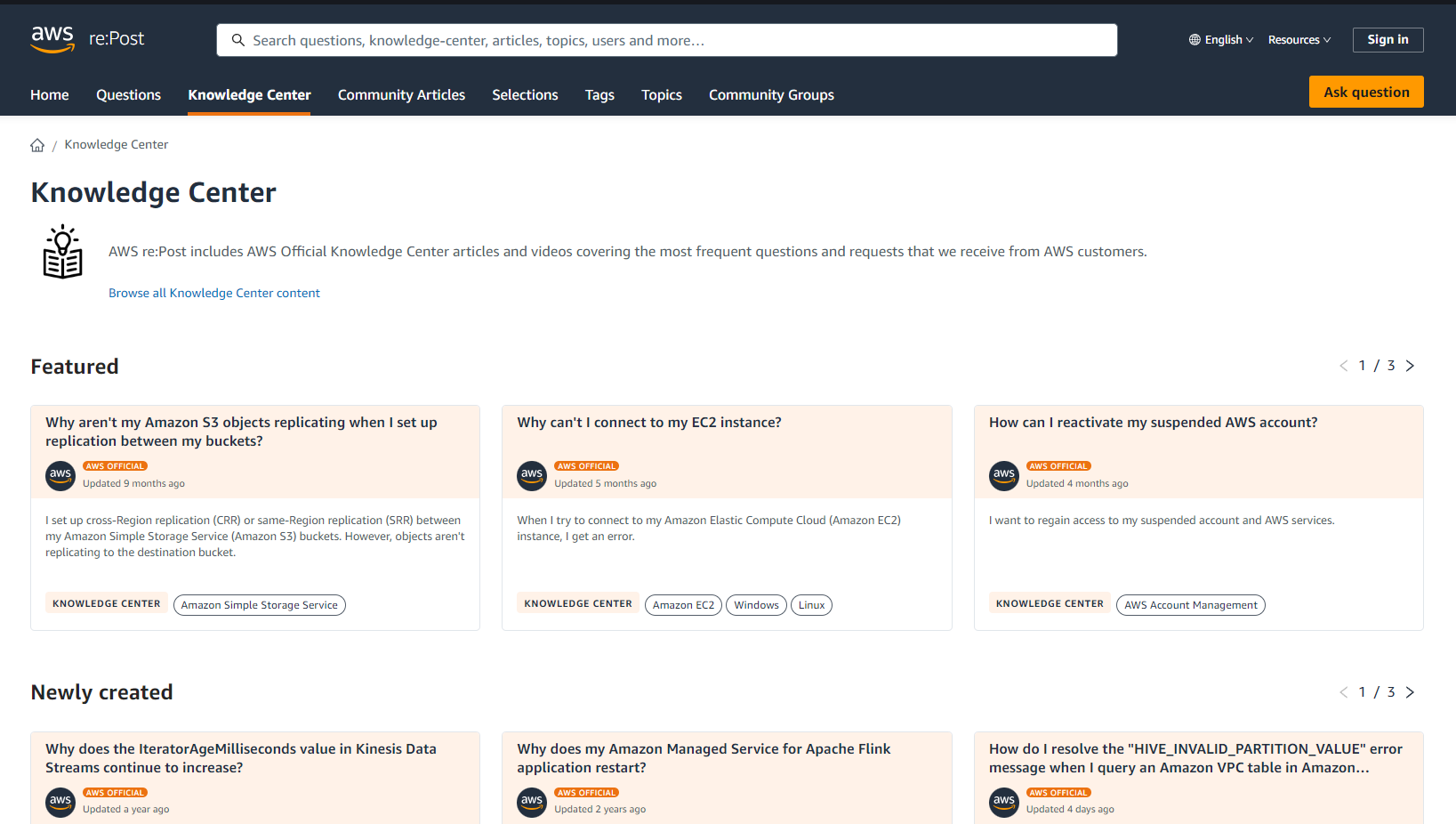
Amazon SES provides technical support through various channels. Knowledge-based articles offer self-help for troubleshooting issues and learning features. Developer-focused documentation provides code references and tutorials.
Additional support requires an AWS Support plan starting at $29/month for email access. Higher tiers enable screen-sharing and expedited responses. Phone support is only available on Enterprise plans.
SES users can also access peer community support in the Amazon SES Discussion Forum on AWS, though conversations tend to be technical.
SendGrid
SendGrid includes 24/7 email and chat support with all plans at no added cost. Standard responses are promised within 24 hours. Phone assistance also comes standard for quicker real-time answers.
Alongside official channels, SendGrid offers community support through its Email Community Forum group on Facebook. Over 15K members trade insights on deliverability, automation, segmentation, and more. An ideas portal also submits suggestions directly to SendGrid’s product team.
Winner: SendGrid
With free 24/7 assistance by email, phone, and chat plus a bustling online community for advice, SendGrid edges Amazon SES for support accessibility. While Amazon SES caters well to developers through docs and forums, the reliance on paid add-on plans for expanded assistance poses a barrier to entry.
SendGrid’s bundled offerings and active Facebook group make troubleshooting and ongoing education simple for any type of user.
6. Integrations
Amazon SES
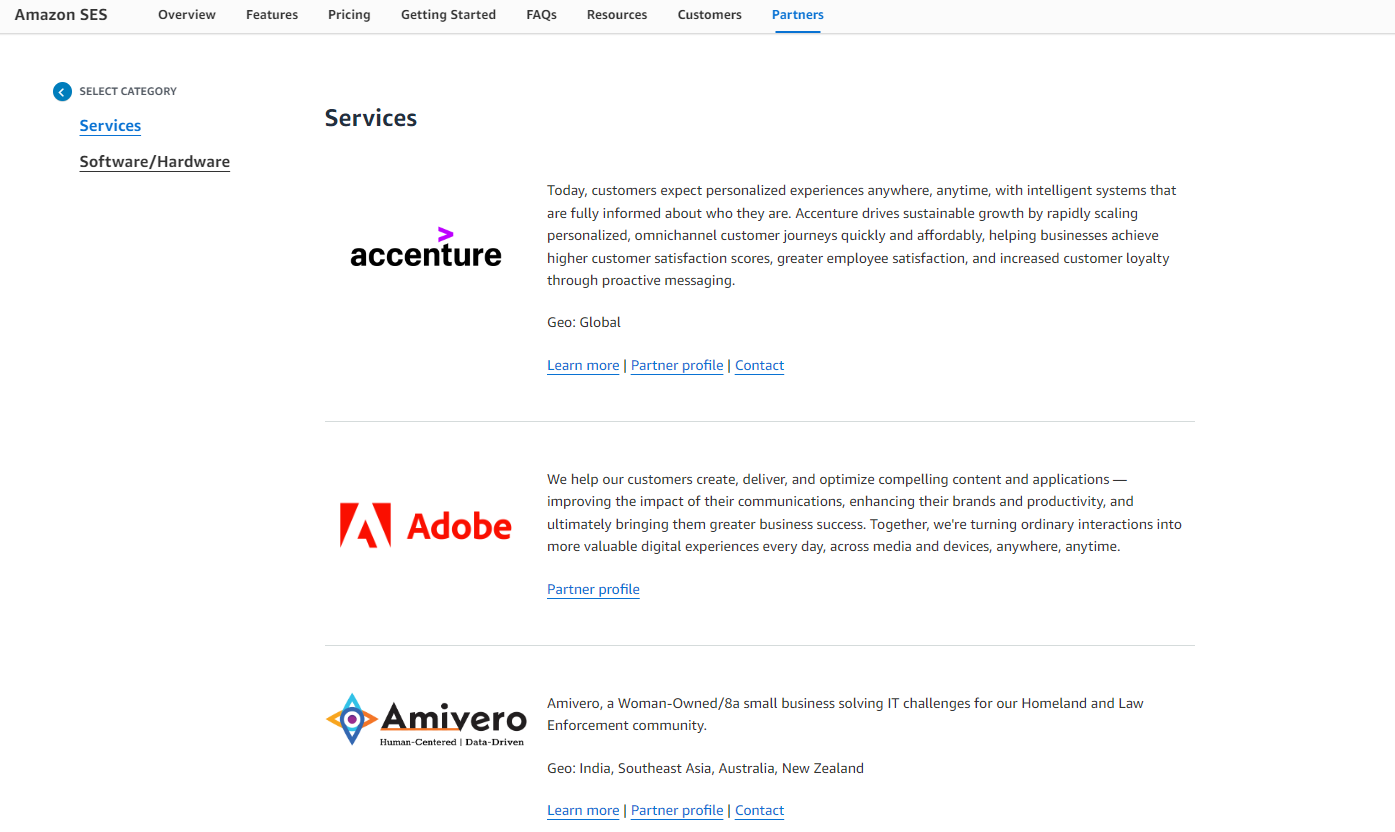
As an AWS service, Amazon SES isn’t just ideal for sending email marketing campaigns or serving as a simple notification service. It also seamlessly integrates with other Amazon offerings including databases like DynamoDB and Redshift, serverless platform AWS Lambda, business analytics with QuickSight, CRM platform Amazon Connect, and more.
These native ties simplify connecting SES workflows across tools like tracking email engagement data and loading subscriber data from databases or piping campaign analytics into business intelligence dashboards. However, integration outside AWS requires API builds or leveraging connectors through Zapier.
Overall, Amazon SES integration complexity mirrors its broader landscape – deeply unified with AWS products but walled off from third parties without development skills.
SendGrid
SendGrid takes an open ecosystem approach with 200+ native integrations with leading apps in every category – CRMs, e-commerce, marketing automation, analytics, and more. Popular platforms like Salesforce, Shopify, and HubSpot connect in just a few clicks via SendGrid plugins and apps.
Zapier support also enables no-code connections to over 2,000 other tools. This flexibility lets users combine SendGrid campaigns with data and workflows from all their critical business platforms.
Altogether, SendGrid accelerates integrating rich email functionality across common martech and business stacks through plug-and-play add-ons.
Winner: SendGrid
While Amazon SES perfectly complements AWS-centric technology, SendGrid’s agnostic platform approach gives it the advantage of ubiquity. The breadth of its native and Zapier integrations provides more diverse options for connecting workflows across tools independent of their underlying architecture. For those leveraging best-of-breed stacks, SendGrid simplifies adding email.
7. Pricing
Amazon SES
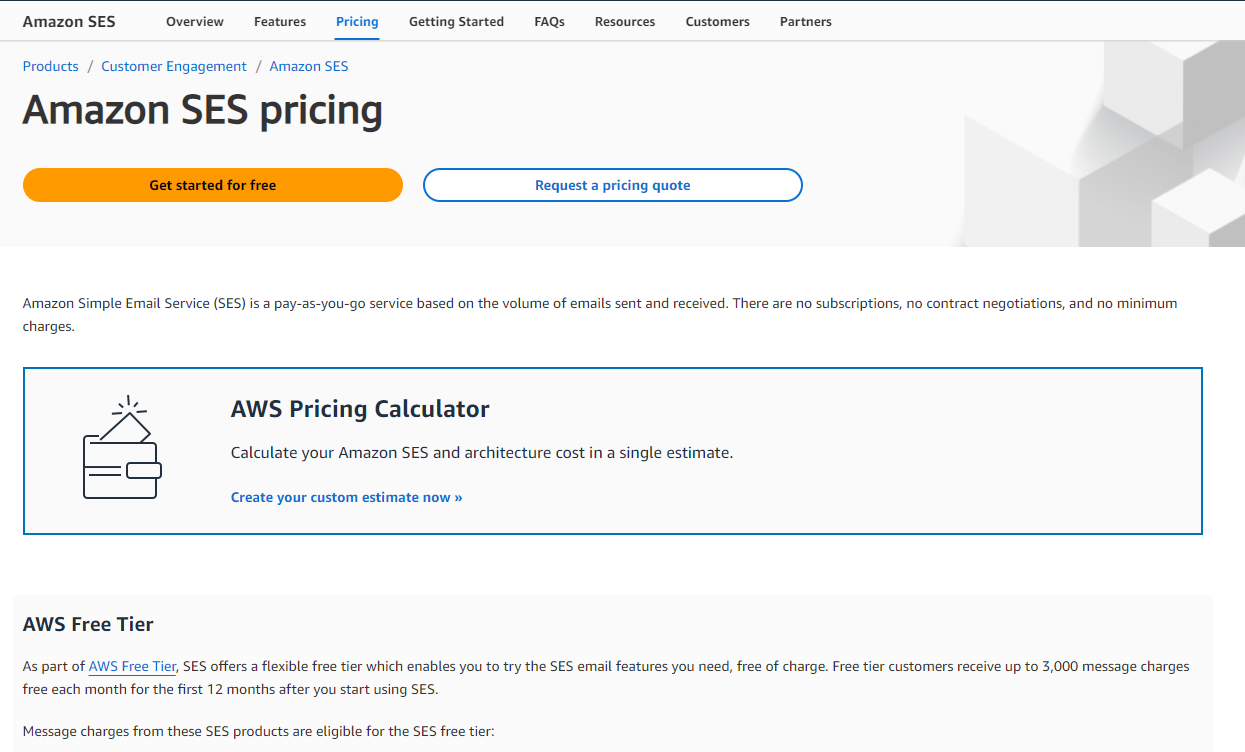
Amazon SES pricing follows a pay-as-you-go model based on email volume sent and received. There is no minimum monthly commitment. Incoming emails are free. Outgoing emails incur charges starting at $0.10 per 1,000 for the first 62,000 emails. Beyond that volume, pricing drops to $0.09 down to $0.048 per 1,000 emails at higher tiers.
Add-ons like dedicated IPs for improved deliverability come at an additional cost. Advanced tools like subscription management, analytics, and more also require integrating other paid AWS services. So the entire SES ecosystem may cost more over time.
Overall, entry-level email sending via SES is very affordable but can rise significantly as needs grow when combining required services.
SendGrid
SendGrid divides pricing between its Free and Paid tiers. The Free plan allows 100 emails/day and 2,000 contacts. Beyond these limits requires a paid plan starting at $15/month for up to 40,000 emails/month.
Each tier includes generous support amounts – 10 emails/second, 50 email templates, 250 contact lists, etc. Common add-ons like dedicated IP address white labeling, domain authentication, and premium support carry extra fees ranging from $5 to $300+ monthly depending on needs.
In total, SendGrid’s paid plans provide strong value for growing email programs based on included functionalities per tier.
Winner: Tie
While Amazon SES excels for high-volume senders through affordable bulk pricing, SendGrid’s free entry plan and feature allowances per paid tier earn points too. Comparing on price alone ignores variables like development costs with SES or limits with SendGrid’s free tier.
Depending on email maturity and tech expertise, either platform can be a cost-effective solution. Both offer pricing suitable to different stages of email adoption.
8. Reviews and Reputation
Amazon SES
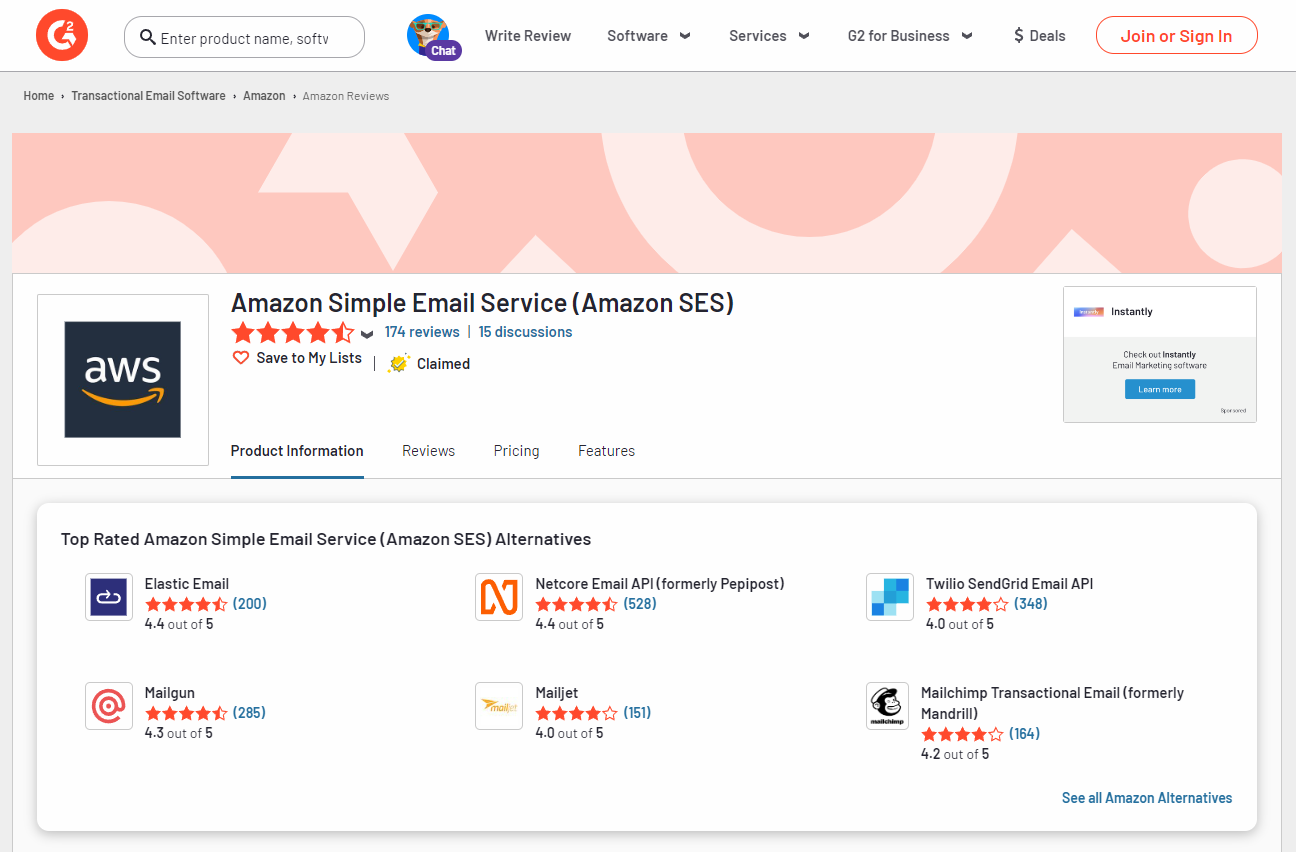
Amazon SES earns strong reviews for its technical capabilities and deliverability power as an enterprise email service. Users praise the scalability to send billions of emails globally through Amazon’s reliable infrastructure. Many also call out competitive pricing for high-volume sending.
However, multiple reviews cite complexity and poor usability as cons, requiring heavy development skills. Navigation and setup challenges cause frustrations around the learning curve. The lack of visualization in reports is another drawback.
On platforms like G2, Amazon SES scores 4/5 from user reviews. However, the recurring theme centers on infrastructure strengths countered by usage difficulties and the need for technical experts.
Read Amazon SES Reviews on G2.
SendGrid
SendGrid garners excellent reviews for making optimized email delivery easy and intuitive across customer types. The vast majority of users highlight simple UIs that quickly get email campaigns running through prebuilt templates, workflows, and analytics. Reliability and deliverability are also rated as top attractions.
Product gaps like lack of native list building or basic A/B testing do surface. Yet most negatives connect to premium pricing at higher tiers. Overall though, SendGrid pleases diverse audiences with its blend of power and simplicity. Across sites like Capterra, SendGrid averages 4.5 out of 5 stars.
Winner: SendGrid
While Amazon SES provides developer-focused email, SendGrid resonates better for delivering capabilities that users across the expertise spectrum can leverage with ease and pleasure.
By balancing robust functionality with accessibility through UX instead of code alone, SendGrid satisfies wider audiences more readily as reflected in holistic reviews. For those seeking simplified but still advanced email marketing services, SendGrid emerges ahead.
9. FAQ’s
Amazon SES FAQs
- What expertise is needed to use Amazon SES?
Amazon SES is designed for developers building applications on AWS. Leveraging the full suite requires knowledge of services like Lambda, CloudWatch, DynamoDB, and coding languages for API integration. Beginners can struggle with complexity. - Does Amazon SES have email templates?
Yes, Amazon SES provides basic templating support. Users can build templates within SES or upload externally designed HTML templates. However, it lacks robust reusable templates or predesigned options common in other ESPs. - How long does it take to deliver email blasts?
Amazon SES infrastructure can deliver high-volume email blasts fast thanks to global cloud servers. However, developers must build custom scripts for blasting beyond normal SMTP sending. Deliver speed aligns with other commercial ESPs.
SendGrid FAQs
- Is SendGrid easy to use?
Yes, Sendgrid earns widespread praise for intuitive UIs that enable all users to create, send, and analyze campaigns without coding. Features like drag-and-drop editors, prebuilt templates, and visual workflow builders simplify the experience. - Does SendGrid offer free plans?
Yes, SendGrid’s free tier supports up to 100 sent emails/day and 2,000 contacts. Paid plans start at $15/month for 40,000 emails/month. Higher volume plans scale up from there for additional cost. - Can SendGrid handle large email blasts?
Yes, SendGrid guarantees fast delivery of email blasts in the millions thanks to horizontally scalable cloud infrastructure. Automation can even stagger large campaigns to avoid triggering spam filters. Reliable blasting aligns with top commercial competitors.
Final Thoughts
Choose Amazon SES if…
With its robust infrastructure and seamless AWS integrations, Amazon SES works best for developers building email functionality into applications. Companies invested heavily in AWS can also leverage SES effectively for marketing and transactional emails. The development focus does limit non-technical teams but makes customization and scalability achievable for skilled coders.
Choose SendGrid if…
SendGrid shines for anyone wanting simplicity without sacrificing deliverability. Intuitive drag-and-drop editors, templates, and analytics accelerate email marketing and engagement tracking for non-developers. Easy integrations also give growing businesses on open technology stacks a reliable foundation for strategic email use.
Ultimately the “right” transactional email service for you depends on your goals, audience size, technical capabilities, and ecosystem. Assessing strengths aligned to your needs and resources helps determine the best choice.
